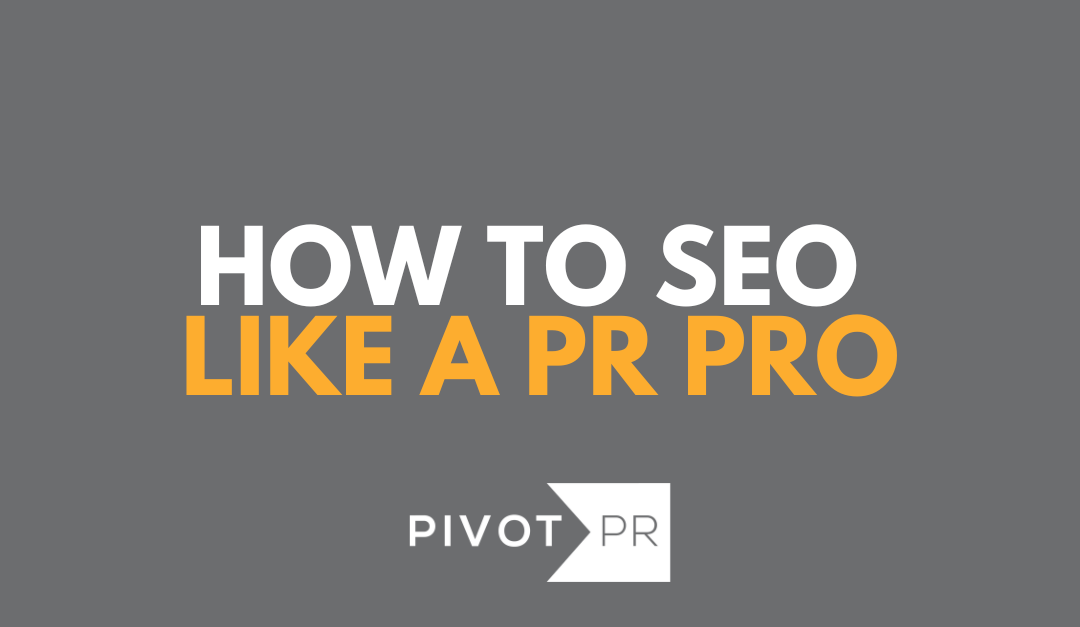
Blog
We all know public relations includes fundamental tactics such as messaging, content creation, awards, rankings, reviews, and of course, media relations. In a world where search engine optimization (SEO) is imperative to a potential customer’s research online, these PR tools can be leveraged to enhance your organization’s visibility, ranking higher and more frequently in search results. Nearly all industries can benefit, so if you want to SEO like a pro, while practicing PR, here are five search engine optimization vernaculars you can’t go without.
- Keyword Research is the process of identifying specific words and phrases your target audience is using to search for information or products online. Locating and using the right keywords in your content significantly increases the chances of your website ranking higher in search engine results. This helps attract more relevant traffic, making it easier for people to find and engage with your content. Google Trends can be a powerful tool to identify keywords.
- Backlinks are links from other websites pointing to your content and are a crucial piece of the SEO puzzle. Simply put, the more high-quality backlinks your site earns, the more authoritative it appears to search engines. This leads to higher search rankings, which means more people will find your business when searching for related topics. This is where SEO can cohesively work with your PR plan, including media relations and content creation. Providing calls to action and incorporating website links in media coverage will boost credibility.
- External Linking is the process of creating hyperlinks on your website to direct users to other sites. This powerful method can increase the credibility of your page in the eyes of search engines like Google. When incorporating links, it’s important to use natural and relevant anchor text, which are terms that naturally flow in the context of your website.
- No-Follow Links are a specific type of backlink that tells search engines not to pass “SEO value” from the linking site to the linked site. These links don’t help improve your search rankings, but they still drive traffic to your website.
- Domain/Page Authority is a score from 1 to 100 that predicts how well a specific page on your website, or the website as a whole will rank in search engine results. The higher the score, the better that page is likely to rank.
Now that SEO is top of mind, you’ll need a tool to analyze your efforts. Moz Link Explorer measures everything we’ve covered for free- domain authority, keyword ranks, backlinks, and spam scores, and it also lists your top search competitors and includes their visibility score.
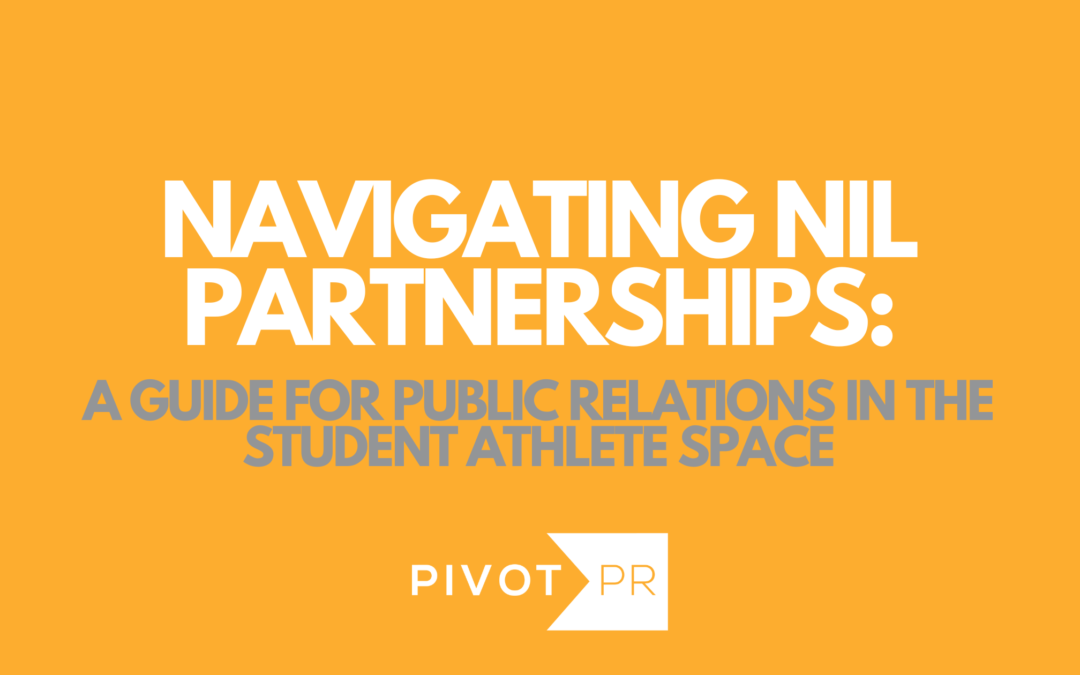
Blog
The landscape of college athletics has transformed dramatically with the emergence of Name, Image, and Likeness (NIL) rights. For public relations professionals, this shift presents both a unique challenge and an exciting opportunity. As college athletes now have the chance to monetize their personal brand, PR strategies must evolve to support these young athletes effectively.
Here’s how PR professionals can navigate the dynamic world of NIL partnerships and leverage these opportunities to foster success.
Understanding the NIL Landscape
NIL rights allow college athletes to receive compensation for their personal brand, including endorsements, sponsorships, and other revenue-generating activities. This paradigm shift, which began in July 2021, has opened new avenues for athletes to build their personal brands while still competing in college sports. For PR professionals, understanding this new legal and commercial framework is crucial for developing effective strategies.
Building a Brand from the Ground Up
One of the primary responsibilities of PR professionals working with college athletes is brand development. Athletes are not just players; they are emerging brands with unique stories and personalities. The role of PR is to identify and amplify these attributes, creating a compelling narrative that resonates with both fans and potential sponsors. This involves crafting personalized press kits, managing social media presence, and securing media coverage that highlights the athlete’s achievements and character.
Creating Authentic Partnerships
Authenticity is key in NIL partnerships. College athletes are often new to the world of endorsements and sponsorships, and PR professionals must guide them in choosing partnerships that align with their personal values and interests. The right partnership should feel genuine to the athlete’s brand and resonate with their audience. PR professionals should facilitate conversations between athletes and potential sponsors to ensure mutual goals and values are aligned, resulting in authentic and impactful collaborations.
One of our clients, Piada Italian Street Food, recently embraced the power of partnering with college athletes for National Piada Gives Day. By carefully selecting athletes who naturally align with its mission, this initiative not only enhanced the brand’s credibility but also fostered a meaningful connection with the community, showcasing that true success in these sponsorships come from shared values.
Navigating Compliance and Regulations
The NIL landscape is still evolving, and regulations vary by state and institution. PR professionals must stay informed about these regulations to ensure that all endorsements and sponsorships comply with legal requirements. This includes understanding the rules set by the NCAA, state laws, and university policies, such as requirements for disclosing deals or limits on certain types of promotions. Keeping abreast of these regulations will help avoid potential pitfalls and ensure that all partnerships are legally sound.
Leveraging Digital Platforms
In today’s digital age, social media and online platforms are crucial for building and promoting an athlete’s brand. PR professionals should work with athletes to develop a robust online presence, utilizing platforms like Instagram, X, and TikTok to engage with fans and attract sponsors. This involves creating a content calendar, choosing NIL-friendly photos and videos, managing posts, and analyzing engagement metrics to refine strategies. Additionally, leveraging digital platforms for collaborations with influencers or brands can amplify the athlete’s reach and impact.
Fostering Long-Term Success
Effective PR strategies for NIL partnerships go beyond immediate gains. It’s about building a sustainable and positive brand presence for the athlete. PR professionals should focus on long-term goals, such as cultivating lasting relationships with sponsors, maintaining a positive public image, and helping athletes successfully transition into their post-college careers.
Working with college athletes in the NIL space requires a nuanced understanding of brand management, compliance, and digital engagement. By focusing on authenticity, strategic partnerships, and long-term success, PR professionals can help athletes navigate this exciting new era and achieve their personal and professional goals. The evolving world of NIL presents a dynamic opportunity for PR professionals to make a significant impact on the careers of emerging sports stars.
To discover how PIVOT PR can enhance your NIL strategy and elevate athlete visibility, email us at [email protected].
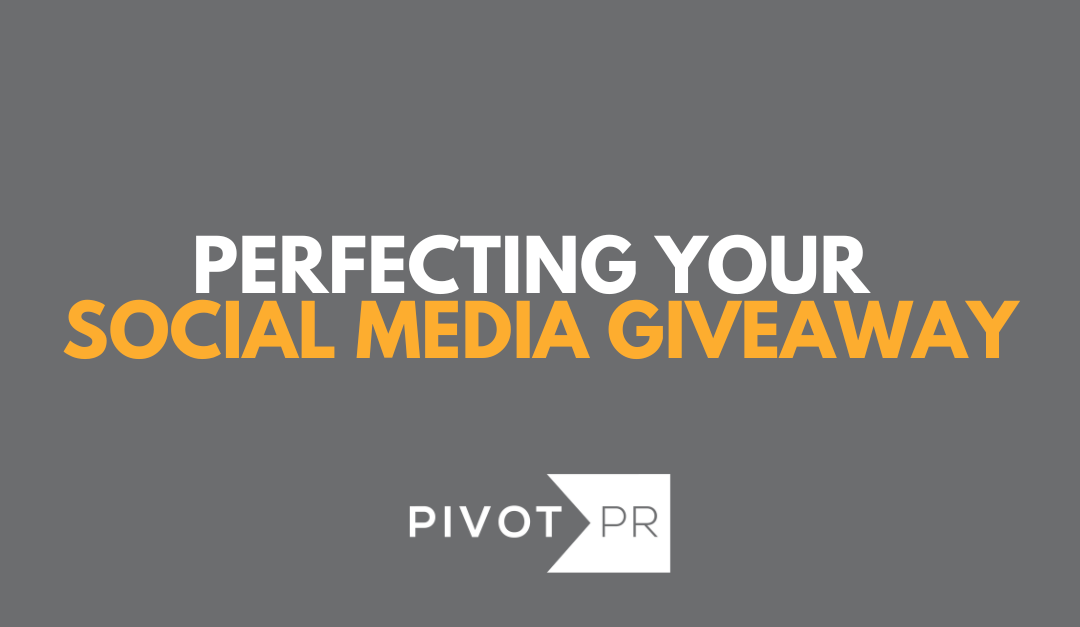
Blog
Growing your following on social media can often be a daunting task. An efficient way to boost follower counts and increase brand awareness is through giveaway marketing. Let’s face it, who doesn’t love winning free stuff?
During social media giveaways, influencers and brands will typically ask users to complete simple tasks such as liking a post, tagging friends in the comments, or filling out a survey. After a predetermined length of time, winners are selected at random to keep everything fair. Here are three steps to successfully execute a social media giveaway:
Determine your goal
Before diving into the deep end, identifying your goals with realistic outcomes will help guide every aspect of your social media giveaway and measure its success. If increasing your follower count is a priority, create a giveaway that encourages users to follow your account. To boost engagement, design your giveaway in a way that encourages users to like, comment, or share your posts. For newsletter subscribers, utilize Google Forms to require participants to submit their email address. Lastly, to raise brand awareness, try collaborating with influencers in your target market to increase your overall reach.
Set your budget
The most pivotal decision in your giveaway is selecting the right prize. Whether it’s new merchandise, tickets to a concert or sporting event, the prize should be enticing enough to motivate participation. Once you’ve decided on the prize, setting a budget is essential. Determine how much you’re willing to spend not just on the prize itself, but also on influencer outreach and advertising. This predetermined budget will guide your giveaway strategy and serve as a template for planning future promotions.
Plan and execute your social media giveaway
Now that you’ve set your goals and budget, it’s time to plan and execute your social media giveaway. Begin by outlining your timeline and guidelines. How long will the contest run for? How many winners will there be? Will there be disqualifying terms? Next, create and schedule your content in a social media calendar or however you keep your social media content organized. This is also the time where conducting influencer outreach will be beneficial. When you’re ready to officially launch the giveaway, notify your audience with a clear and easy to read post that outlines the rules to entry and the prize offered. To maximize the impact of your giveaway, we encourage running ads and boosting content. Lastly, sit back and enjoy as the entries flow in!
Running a social media giveaway can be a fun and effective way to engage with your audience and achieve your marketing goals. By setting clear objectives, budgeting wisely, and executing with careful planning, you can create a successful giveaway that drives results and enhances your brand’s presence. Good luck!
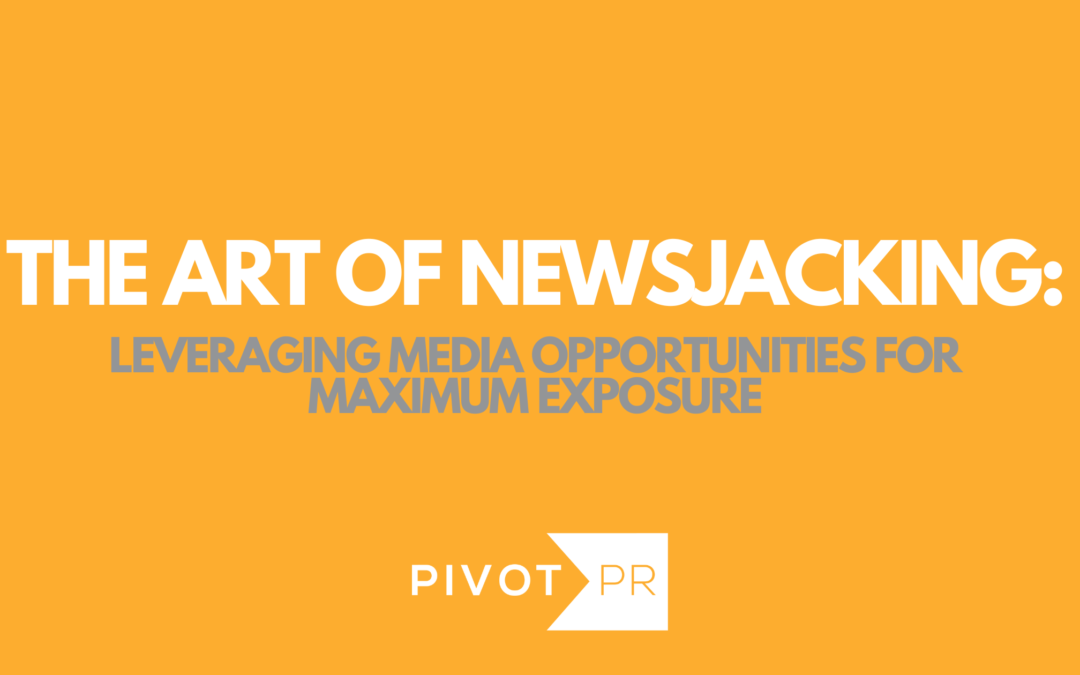
Blog
In the fast-paced industry of public relations, staying ahead of the curve is crucial. One effective strategy our team at PIVOT PR utilizes to gain media attention and boost our client’s visibility is newsjacking. This technique can bring more visibility and awareness to a brand by generating significant media coverage. In this blog post, we’ll explore what newsjacking is, why it’s effective, and how you can master this art to create impactful media opportunities.
What is Newsjacking?
Newsjacking refers to the practice of injecting your company or ideas into a breaking news story to gain media attention and amplify your brand’s message. It involves quickly reacting to news events and creating relevant content that aligns with the story, thereby positioning your brand as a thought leader in the industry.
Why Newsjacking Works
Newsjacking capitalizes on the immediacy of breaking news, making your content relevant and engaging. By associating your brand with trending topics, you increase the likelihood of being noticed by journalists, influencers, and the public.
One of the best examples of newsjacking from our team resulted in a story in The Washington Post when the largest port in Ukraine reopened during the Russia/Ukraine War. We saw the port was opening, and immediately sent out a rapid response pitch leveraging the news and offered thoughtful commentary from our client.
Steps to Successful Newsjacking
- Stay Informed: Regularly follow reputable news sources, industry blogs, and social media platforms to stay updated on current events.
- Act Quickly: The success of newsjacking hinges on your ability to act swiftly. As soon as a relevant story breaks, create content promptly and distribute it to a highly targeted media list. Ensure you have a streamlined approval process to avoid delays in publishing your content.
- Choose the Right Story: Select news stories that are relevant to your industry, brand, or audience. Avoid sensitive or controversial topics that could backfire and harm your brand’s reputation.
- Identify the Ideal Expert: Have a credible subject matter expert ready to give their expertise on the breaking story and be available for interviews if need be.
- Create Compelling Content: Offer a fresh perspective or unique insight related to the news story.
- Promote Your Content: Pitch your story to journalists and media outlets that cover your industry.
Newsjacking is a powerful tool for creating media opportunities and boosting your brand’s visibility. By staying informed, acting quickly, and crafting compelling content, you can effectively leverage breaking news stories to enhance your PR efforts. Remember, the key to successful newsjacking lies in relevance, timeliness, and authenticity.
To explore how PIVOT PR can utilize tactics such as newsjacking and more to elevate your brand’s visibility and awareness, email us at [email protected].
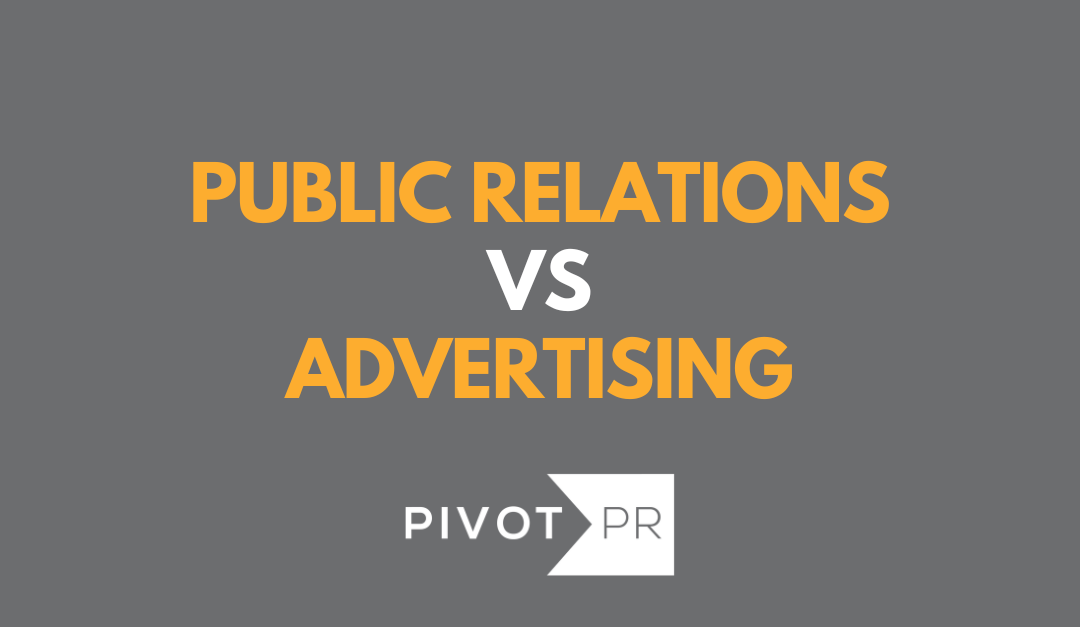
Blog
In the ever-evolving landscape of communication, the lines between public relations (PR) and advertising have often crossed. As a PR agency committed to navigating these strategic crossroads, we’re pulling back the curtain to explore the differences and similarities between PR and advertising, and what tactic you should use when.
The Differences
- Amount of Control: At its core, advertising is paid media. Brands pay for ad space and have complete control over the content, placement, and timing. PR, on the other hand, is earned media. It involves pitching stories to media outlets and influencers, relying on their interest and willingness to share your message.
- The Goal: Advertising aims to drive sales through direct and persuasive messaging about a product or service. PR is about building and maintaining a positive reputation through storytelling and relationships. These narratives don’t always have a direct call to action related to sales and focus instead on establishing trust and credibility over time.
- Lasting Impact: The impact of advertising can be powerful but sometimes short lived, as its presence has a direct correlation to the duration of a campaign’s budget. PR can often last longer, continuing to benefit a brand well beyond the initial investment.
The Similarities
Despite their differences, both PR and advertising share a common goal: to elevate a brand’s presence in the market. The two strategies aim to communicate with target audiences and shape brand perception. In the integrated marketing communications era, successful brands often leverage both PR and advertising, creating a relationship where each complements the other for maximum impact.
Navigating Which to Use When
The decision to lean toward PR or advertising hinges on your immediate goals, audience, and budget:
- For Immediate Sales and Measurable ROI: If your goal is to drive immediate sales or specific actions (for example sign-ups, downloads, etc.), and you are looking for measurable ROI metrics, advertising is your go-to. The direct and controlled nature of ads allows for targeted messages aimed at eliciting immediate responses.
- To Build Trust and Brand Authority: If your goal is to manage brand reputation, establish thought leadership, or build long-term relationships with your audience, PR will best serve your needs.
- Limited Budgets with Long-Term Vision: For startups or companies with limited budgets but a long-term vision, prioritizing PR can be a cost-effective strategy. Earned media, though challenging to secure, provides substantial credibility and audience reach without the larger price tag of paid ad spaces.
- Integrated Campaigns for Amplified Impact: When goals align and resources permit, an integrated campaign utilizing both PR and advertising can amplify your brand’s message. Advertising can increase visibility and direct responses, while PR solidifies brand’s reputation and establishes trust.
Mastering the nuances of public relations and advertising is key to crafting impactful communication strategies that shape positive brand perception and drive results. Whether you’re aiming for immediate impact or nurturing long-term trust, the choice between PR, advertising, or a strategic blend of both, holds the key to achieving heightened impact and long-lasting influence; far beyond the boundaries of a single campaign, ad, or story.
Need a hand with your PR strategy? Reach out to us at [email protected]!




